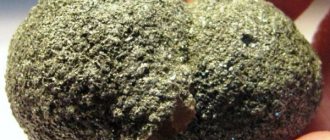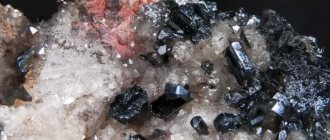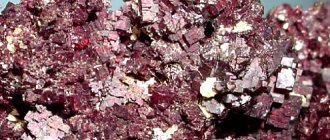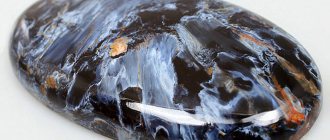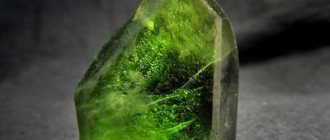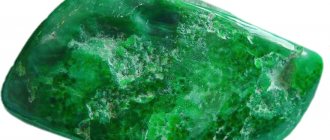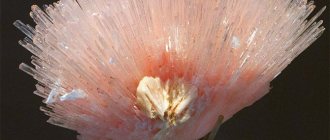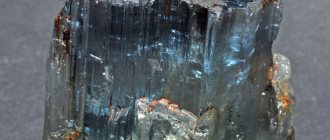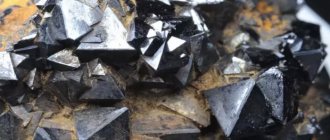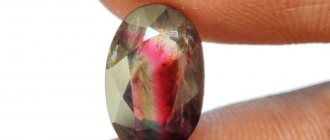Chemical composition
Chemical theoretical composition from the formula Cu5FeS4: Cu -63.33; Fe—11.12; S—25.55. Significant variations in composition are observed: Cu—from 52 to 65%, Fe—from 8 to 18%, S—from 20 to 27%; Fluctuations in Cu content are usually caused by mechanical inclusions of other minerals, most often chalcopyrite, chalcocite and covellite, found in polished sections under a microscope. Regardless of this, the composition of bornite varies significantly, since bornite can contain chalcopyrite and chalcocite in the form of a solid solution. B. often contains Ag as impurities. Impurities are identified spectroscopically: Ag, Bi, In, as well as Ga, Pb, Sb, As. Ce is found in some bornites, possibly due to the presence of renerite inclusions.
Crystallographic characteristics
Syngony. Tetragonal. Axle ratio, a/c - 2,000.
Two natural low-temperature modifications have been identified and observed together (Doney et al.).
- Rhombic system, pseudocubic;
- Cubic
In addition, artificial, cubic modifications are known: low-temperature and high-temperature.
Symmetry class. Tetragonal-scalenohedral - 42t.
Crystal structure
Structurally, the modifications differ in the degree of lattice ordering. The cubic modification has a disordered structure, while the rhombic modification has an ordered structure. The structure is close to that of spinel with a very close packing of S atoms, with Fe atoms in tetrahedra and a somewhat uncertain arrangement of Cu2 atoms.
Main forms:
Observed forms (in a cubic setup): a(100), c7(110), o(111), (1(322), n(211), a(533).
Variety
Only true experts can understand the value of a stone. It was they who noticed the similarity of the inner glow of a translucent stone from the depths with Chartreuse, alluring, mysterious and elusive. The shine and inner glow make it unusual. Among the first connoisseurs of crystals were Zulu shamans, who saw petrified tears of past troubles in the whitish, greenish glass stones, a symbol of forgotten dreams and lost illusions.
Prenit, given to the world in the 18th century, appeared in all its charm. He sparkled with a palette of newly discovered gems:
- Colors found in nature:
- gray greens;
- brown-yellow;
- yellowish green;
- white;
- colorless;
- grey.
- Gray, green and whitish (with a moonlight effect) in numerous unique shades, the gems are distinguished by their pearlescent and glassy luster.
- Yellow minerals from the Australian deposit (gold, apple, onion flowers).
- Amazing examples of color combinations reminiscent of a cat's eye (green with iridescence).
- The richness of the palette of translucent gems puts them on a par with valuable minerals:
- pomegranate;
- rock crystal;
- moonstone.
It is classified as a precious stone. With its green tint, the gem vaguely resembles chrysoprase. The colors are distributed unevenly, with inclusions of rutile needles or spots in the depths of the translucent gem.
Physical properties of bornite
Optical
- Color. Copper-red, bronze-yellow with a reddish tint, violet with blue tarnish. On a fresh fracture, dark copper-red; On a stale fracture, bright mottled tarnish is common.
- The streak is greyish-black.
- Semi-metallic luster
- Transparency Opaque.
Mechanical
Bornite grains in the rock. Middle Asia. Chorukh-Dairon.
- Hardness 3. Brittle.
- Density 4.9—5.3
- Cleavage at (111) is very weakly expressed.
- The fracture is finely conchoidal.
Where is the stone mined?
There are mineral extraction sites on almost all continents:
- Europe - Italy, Austria, Germany, Poland.
- America – USA, Chile, Peru. Raw materials from South America are famous for their decorative qualities, occurring in “variegated ore”.
- Asia – Kazakhstan (the largest agglomerates, up to 7–8 cm).
- Africa – Namibia.
- Russia – the Urals and Transbaikalia.
However, solid deposits are rare.
The mineral of hydrothermal origin coexists in the rocks with azurite, cuprite, limonite, and malachite.
Chemical properties
It dissolves in HNO3 with the release of S. In polished sections, it boils from HNO3. Easily etched by KCN, sometimes FeCl3. HCl, KOH, H2SO4 have no effect. The structure is revealed by the action of a solution of J in KJ
Other properties
Paramagnetic At 170°, the transition of the rhombic (pseudo-cubic) modification to cubic begins with heat absorption; at 220° the transition is complete. During rapid cooling, the cubic lattice is retained. At 260°, dissociation begins, followed by oxidation (heat release). At high temperatures, it forms solid solutions with chalcopyrite (according to Grigoriev - chalcobornite), which disintegrate as the temperature decreases to form various intergrowths of both minerals. Decay, according to Filimonova, occurs at a temperature of 270°, according to Schwartz - at 475°. Grigoriev and Sugaki note that the decomposition temperature varies depending on the composition.
How does it affect the psyche?
- Since fluorite affects the highest chakra Sahasrara, it gives a feeling of harmony and tranquility. Helps people with unstable psyches, relieves anger and irritation. Improves the ability to communicate with people.
- Helps get rid of unproductive behavior patterns. Gently removes suppressed feelings from the subconscious. Makes its owner more self-confident.
- Frees you from obsessions that torment a person, helps you overcome the limitations of consciousness.
- If you have to act impartially and objectively, it is recommended to wear a talisman with fluorite.
The mineral is an excellent assistant in gaining knowledge. The green option enhances concentration, promotes better learning, energizes and gives motivation to learn. The purple crystal allows you to work more productively in your studies, and not give up what you started as soon as you get bored. Transparent reveals extraordinary ways of thinking and transfers ideas from the spiritual world into everyday reality.
Artificial production of mineral
It is obtained by fusing a mixture in vacuum, the composition of which corresponds to the formula of the mineral with some excess of S2. Dölter (1925) obtained bornite by passing H2S over moderately heated (up to 100-200°) iron and copper oxides in a tube. It is formed as a result of diffusion in the solid phase between chalcopyrite and covellite, as well as between chalcocite and pyrite.
Diagnostic signs
Similar minerals. Covelline, if bornite is oxidized and has intense tarnish.
Easily recognized by its color, variegated tarnish and low hardness. The color of a fresh fracture is similar to nickel, pyrrhotite, and also to the very rare germanite. Due to its bright blue tarnish, it can be mistaken for covellite, but differs sharply from the latter in color when freshly fractured. Under a microscope in reflected light, unlike pyrrhotite, it has lower hardness, lower reflectivity and a denser color; it differs from nickel in lower hardness and significantly less reflective. ability and weak anisotropy, from germanite - darker color and anisotropy.
Satellites. Chalcopyrite, chalcocite, sphalerite, pyrite, galena, magnetite, titanomagnetite, enargite, malachite, azurite, less commonly cuprite, molybdenite and gold.
Compatibility with Zodiac signs
The gem is younger than many stones in age. But the monks of South Africa and Australian residents discovered healing powers and magical properties in it. Forecasters and shamans used its power to develop intuition. Prehnite with rutile inclusions has become an amulet for returning forgotten dreams and attracting prophetic dreams.
There is still debate about who the stone is suitable for. Its astrological properties have not been sufficiently studied. Magicians and soothsayers attribute the stone to Libra. They advise all other signs, except Cancer, to take a closer look at it.
The gem brings peace and tranquility. If the owner likes it, he will be happy with the amulet or decoration. Not a single zodiac sign will suffer from his spell.
| Signs | Compatibility |
| Scales | It is recommended to wear the gem in amulets, amulets, and jewelry. The mineral is completely compatible with this sign. It will balance the external softness of the sign with the underlying hardness, and will help create a difficult relationship with reality. |
| Gemini and Aquarius | The stone will help you find your other half. |
| Taurus, Capricorn and Virgo | An amulet with a crystal will provide protection against illnesses. |
| Aries, Sagittarius and Leo | Learn to analyze events. Jewelry with prehnite will teach you to distinguish good from evil. |
| Pisces | Get rid of apathy, stress and depression. Energy will create spiritual comfort. |
| Raku | Incompatible with the energy of the stone: it affects the intensification of negative emotions, secrecy, and inertia. |
Owners of the stone feel harmony and peace of mind. It symbolizes modesty. Using a gem for meditation brings peace and tranquility. The gem brings back memories. Women wearing it assert their leadership position among people.
Origin and location
It is formed by the “pegmatite”, pneumatolytic-hydrothermal route together with chalcocite and enargite, secondary in zones of secondary sulfide enrichment with malachite, azurite, and less commonly cuprite.
A widespread mineral found in many copper deposits. Has various origins. As a hypogene mineral, it occurs over a wide temperature range. During supergene processes, it is formed in the zone of secondary sulfide enrichment. Isolations of supergene bornite are known in sedimentary rocks, sometimes in the form of pseudomorphs from organic residues.
Therapeutic effect
Healers have established that bornite emits only positive energy. Suitable for solving primarily women's problems:
- inflammation of the genital organs;
- infertility;
- problematic pregnancy.
A talisman with bornite is taken with women in labor to give birth faster and easier.
The stone is useful for everyone (including children) for chronic diseases of the heart, kidneys, and pancreas. He is placed in the sick bed for a short time.
Place of Birth
Hypogenic bornite forms dissemination in basic igneous rocks in association with chalcopyrite and titanomagnetite, for example, in the Volkovskoye deposit in the Sverdlovsk region, in the Engels River (California, USA). In hydrothermal deposits it is usually found in association with various copper and other sulfides, most often with chalcopyrite, pyrite, sphalerite, fahlore, galena, enargite, chalcocite, and sometimes also with molybdenite and gold. Quite often it is observed in deposits such as pyrite deposits: Levikha, im. III International, Voroshilovskoye (Sverdlovsk region), etc., in the Urals, Alaverdi (Armenia), Gadabek (Azerbaijan), etc. in Transcaucasia, Krasen (Bulgaria), etc. Distributed in vein copper and lead-zinc deposits - Kafan ( Armenia) and a number of others in Transcaucasia, Uspenskoe (Kazakhstan), Butte (Montana, USA), Tsumeb (Southwestern Africa), etc. Contained in deposits such as cuprous sandstones and shales—Dzhezkazgan (Kazakhstan), Mansfeld ( Germany). In Tuva auto. region found in gold-copper-molybdenum ores. In the zone of secondary sulfide enrichment, B., as the earliest secondary copper sulfide, develops mainly due to chalcopyrite, less often - due to sphalerite, pyrite and other minerals that are part of the primary ores; This type of fermentation is observed in almost all copper sulfide deposits, but usually does not produce any significant accumulations and forms irregular veins, rims, or irregular segregations.
How to serve whitefish: a simple way
The finished fish is peeled and the bones are removed. Cut into small pieces and salt. Place the slices in a jar. Take a couple of onions, peel and cut them into thin half rings, and place them on the fish. Another layer of whitefish, then onions. Pour vegetable oil over everything and leave for a while.
Before guests arrive, transfer the fish and onions to a serving plate. You can decorate the dish with lettuce leaves. You can also prepare croutons or bread in advance on which the fish slices will be placed.
Crystal optical properties in thin preparations (sections)
In polished sections in reflected light, in a fresh state it is pinkish-brown; in air it very quickly becomes darker, with a violet tint. Reflectivity (in%): for green rays 18.5, for orange - 19, for red - 21. Measurements with a photocell give 26.3 and 27.4 for orange and red rays, respectively. Bi-reflection in weakly anisotroic differences is barely noticeable with immersion. Isotropic, sometimes very slightly anisotropic (only in freshly polished sections). Lamellar, lattice and other structures of intergrowth with chalcopyrite are characteristic as a result of decomposition during cooling of solid solutions of chalcopyrite in bornite. Often, regularly oriented chalcopyrite inclusions are found in bornite, located parallel to (100), less often parallel to (111) and (332). Graphic intergrowths of bornite with chalcocite are very characteristic. Tiny inclusions are also often noted, which may belong to renerite, wittichenite and a more unidentified mineral (“orangebornite” according to Orcel and Plaza); the latter is somewhat lighter than bornite, noticeably bi-reflective, highly anisotropic, not etched by HNO3 and is characterized by the presence of twin plates.
Price
Jewelry and collectibles are available even to people with little income.
Collection material (cost, rub.):
- bornite (sinter, 2.2x1.8x1.5 cm) – 150–260;
- bornite (agglomerate 11x7x3.8 cm) – 4,500;
- bornite on calcite (8x3.6x3 cm) – 1200;
- bornite with chalcopyrite (6x4.4x2.3 cm) – 1,960.
All samples are from the Dzhezkazgan deposit (Kazakhstan).
Pendant with bornite
Jewelry (cost, rub.):
- set of three pendants (bornite, variscite; 5x2, 3.5x1.5, 3.5x1.5 cm) – 550;
- pendant (bornite, variegated copper, bronzite; silver 925°) – 4,650;
- pendant (bornite, variscite) – 315;
- necklace (bornite, bronzite, coral, selenite) – 1,850.
These are the prices of original works.
